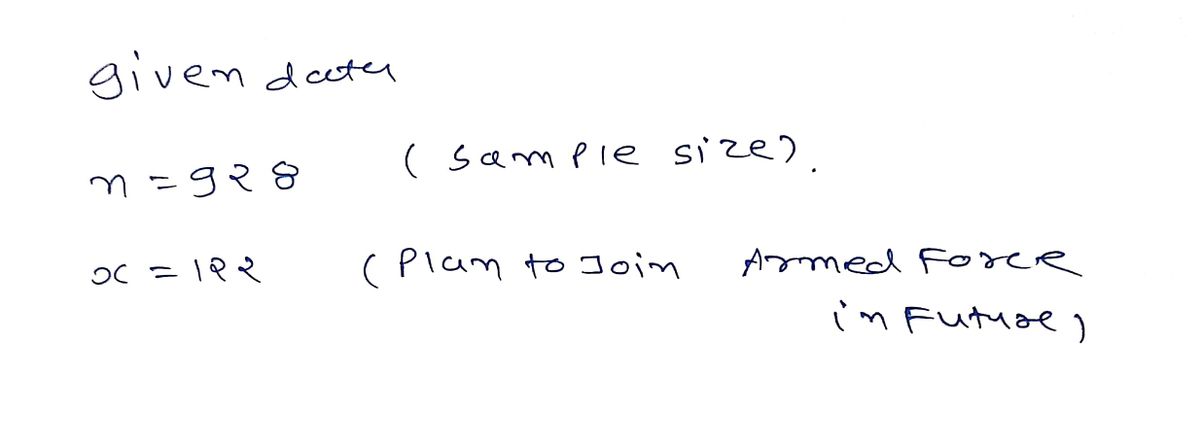Let p be the population proportion for the following condition. Find the point estimates for p and q. Of 928 children surveyed, 122 plan to join the armed forces in the future. ..... The point estimate for p, p, is . (Round to three decimal places as needed.) Vi Vi (1,1) TC
Let p be the population proportion for the following condition. Find the point estimates for p and q. Of 928 children surveyed, 122 plan to join the armed forces in the future. ..... The point estimate for p, p, is . (Round to three decimal places as needed.) Vi Vi (1,1) TC
A First Course in Probability (10th Edition)
10th Edition
ISBN:9780134753119
Author:Sheldon Ross
Publisher:Sheldon Ross
Chapter1: Combinatorial Analysis
Section: Chapter Questions
Problem 1.1P: a. How many different 7-place license plates are possible if the first 2 places are for letters and...
Related questions
Question
Answer these question
![In this educational exercise, we are tasked with finding the point estimate for the population proportion (denoted as \( p \)) and its complementary probability (denoted as \( q \)) based on survey data.
**Problem Statement:**
Let \( p \) be the population proportion for the following condition. Find the point estimates for \( p \) and \( q \).
- **Data Given:**
- Out of 928 children surveyed, 122 plan to join the armed forces in the future.
**Solution:**
To find the point estimate for \( p \), which is the proportion of children planning to join the armed forces, use the formula:
\[
\hat{p} = \frac{x}{n}
\]
where:
- \( x = 122 \) (number of children planning to join)
- \( n = 928 \) (total number of children surveyed)
Substitute the given values:
\[
\hat{p} = \frac{122}{928}
\]
Calculate and round to three decimal places as needed to obtain the final point estimate.
Once \( \hat{p} \) is determined, the point estimate for \( q \), which is the proportion of children not planning to join the armed forces, can be found using:
\[
\hat{q} = 1 - \hat{p}
\]
**Additional Features:**
- **User Interface Options:**
- Help Me Solve This
- View an Example
- Get More Help
- Clear All
- Check Answer
These options provide tools for step-by-step guidance, examples for better understanding, and a feature to check the correctness of the calculated answer.](/v2/_next/image?url=https%3A%2F%2Fcontent.bartleby.com%2Fqna-images%2Fquestion%2Fdabeff17-6e30-4e7b-b604-e664e91c4527%2F0f86a2c8-4117-489b-8aa1-09f3a91ec657%2Fag6lgn5_processed.jpeg&w=3840&q=75)
Transcribed Image Text:In this educational exercise, we are tasked with finding the point estimate for the population proportion (denoted as \( p \)) and its complementary probability (denoted as \( q \)) based on survey data.
**Problem Statement:**
Let \( p \) be the population proportion for the following condition. Find the point estimates for \( p \) and \( q \).
- **Data Given:**
- Out of 928 children surveyed, 122 plan to join the armed forces in the future.
**Solution:**
To find the point estimate for \( p \), which is the proportion of children planning to join the armed forces, use the formula:
\[
\hat{p} = \frac{x}{n}
\]
where:
- \( x = 122 \) (number of children planning to join)
- \( n = 928 \) (total number of children surveyed)
Substitute the given values:
\[
\hat{p} = \frac{122}{928}
\]
Calculate and round to three decimal places as needed to obtain the final point estimate.
Once \( \hat{p} \) is determined, the point estimate for \( q \), which is the proportion of children not planning to join the armed forces, can be found using:
\[
\hat{q} = 1 - \hat{p}
\]
**Additional Features:**
- **User Interface Options:**
- Help Me Solve This
- View an Example
- Get More Help
- Clear All
- Check Answer
These options provide tools for step-by-step guidance, examples for better understanding, and a feature to check the correctness of the calculated answer.
Expert Solution
Step 1

Step by step
Solved in 2 steps with 2 images

Recommended textbooks for you

A First Course in Probability (10th Edition)
Probability
ISBN:
9780134753119
Author:
Sheldon Ross
Publisher:
PEARSON


A First Course in Probability (10th Edition)
Probability
ISBN:
9780134753119
Author:
Sheldon Ross
Publisher:
PEARSON
